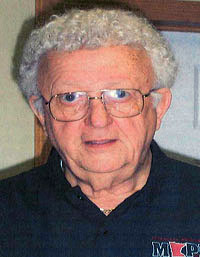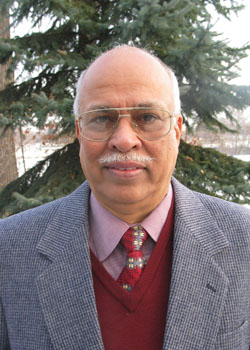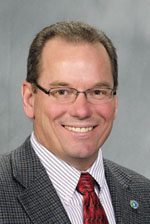 |
|

|
 |
TABLE of CONTENTS
 |
Two Central Office employees pass away |
Bob Richards

Bob Richards, Labor Compliance. Photo courtesy of Richard's Family |
Bob Richards, a 17-year employee with MnDOT’s Labor Compliance Unit, lost his battle with cancer Nov. 20. He was 76 years old.
“Bob loved assisting the contractors and construction employees that worked on MnDOT’s construction projects,” said Charles Groshens, Labor Compliance unit supervisor. “His energy, enthusiasm, work ethic and willingness to help others will be missed.”
Prior to his employment with MnDOT, Bob worked for the Minnesota State Patrol for more than 30 years. He also was active with MAPE Local 801 where he served as president, chief steward and treasurer.
Richards is survived by his wife, three children and five grandchildren.
Funeral services are set for 11 a.m., Nov. 29, at St. Odilia Catholic Church in Shoreview. Visitation will be held Nov. 28 at the Roseville Memorial Chapel from 4 to 8 p.m., and 30 minutes prior to funeral services on Nov. 29.

John Ward, Office of Information Technology Services. Photo by Bill Ward |
John Ward
John Ward, Office of Information and Technology Services, passed away Nov. 19. He was 56 years old.
Ward was driving home Dec. 11, 2009, when his automobile was rear-ended by another vehicle. The impact of the initial hit spun Ward’s vehicle into oncoming traffic, where it was struck by a second vehicle. He was paralyzed from the crash.
“John was a very thorough person with a good eye for detail,” said Bob Bennett, Network Operations supervisor. “He was warm, friendly and a lot of fun to be around.”
A funeral service and remembrance memorial will be held at 11 a.m. on Nov. 26 at North Springs Church in Lino Lakes.
|
 |
|

|
 |
TABLE of CONTENTS
 |
Public input helps create a ‘transportation vision for generations’ |
Ensuring accessibility, building to a maintainable scale and connecting key regional centers are among the eight guiding principles that form the state’s new 50-year vision for transportation.
“The ‘Minnesota GO’ vision is a transportation vision for generations,” said Commissioner Tom Sorel. “These are long-range objectives for all parts of the state’s transportation system that may take decades to be fully realized, but will ultimately help our communities achieve a high quality of life, a competitive economy and a healthy environment.”
The vision is the result of months of work spearheaded by the Office of Statewide Multimodal Planning that included input from the public and diverse representatives of the transportation community.
MnDOT and other transportation organizations will use the vision and information from this project to develop short-term and long-term plans. The vision will offer guidance in determining the transportation initiatives that the state chooses for investment and will serve as the basis for updating the 20-year Statewide Multimodal Transportation Plan beginning this fall. Updates to MnDOT’s plans for highways, rail, aviation, transit, freight and non-motorized transportation will also follow, so that all of MnDOT’s plans fully reflect the Minnesota GO vision.
“Although MnDOT initiated the effort to develop the vision, this is a vision for all forms of transportation,” Sorel said. “It is intended to guide planning for Minnesota’s multimodal transportation system.”
The Minnesota GO vision for transportation has a wide range of implications for different parts of the transportation system. Examples include:
- Waterways, rail, transitways, roads, trails, airports and pipelines that are integrated and strategically located to enable critical connections for Minnesota’s businesses and communities
- An integrated network of streets, roads and highways that collectively support freight, mass transit, non-motorized transportation and personal vehicles
- Reliable and affordable transit options for people who cannot or choose not to operate a personal vehicle in both rural and urban areas
- Connected options to walk and bike
- Zero deaths or serious injuries in any form of transportation
- An environment that allows safe travel using multiple modes for both an 8-year-old and an 80-year-old in every neighborhood and community
A number of opportunities and challenges were considered during the development of the vision, including the effects on transportation and communities of an aging and increasingly diverse population; the continued trend towards people living in cities rather than rural areas; shifts in energy sources and consumption; advances in vehicle technologies; and persistent budget challenges.
“The vision was informed by these trends, but ultimately reflects the priorities of our stakeholders,” said Mark Nelson, Statewide Multimodal Planning director.
To view the vision, visit the Minnesota GO website at www.minnesotago.org.
Minnesota GO Family of Plans
Minnesota GO started with the vision, but extends to an entire family of plans that provide direction for different transportation modes—highways, transit, rail, bikes, pedestrians, freight and aviation. The Statewide Multimodal Transportation Plan serves as the framework plan for MnDOTs family of plans, or the modal plans. This multimodal plan establishes guidance and priorities for state transportation decisions, which filters down into specific plans for each mode and into the Statewide Transportation Improvement Program that identifies priority projects and how money will be spent. To keep pace with changing priorities, opportunities, and challenges, the Statewide Multimodal Transportation Plan and the different modal plans are updated every four to six years; the STIP is updated annually.
There are currently two modal plans undergoing updates. An update to the Statewide Aviation Plan will be completed in the first half of 2012. Updates to the current Highway System Investment Plan will take place in 2012-2013.

|
|
 |
|

|
 |
TABLE of CONTENTS
 |
Jim Close becomes chief information officer |

Jim Close, chief information officer, will continue to direct the Office of Information and Technology Services and coordinate MnDOT’s role in the IT consolidation. Photo by Nick Carpenter |
Jim Close has been appointed chief information officer. He replaces Kathy Hofstedt Bode, who retired Aug. 22.
Close had been serving as acting chief information officer since Aug. 23. In his role as MnDOT CIO, he will continue to direct the Office of Information and Technology Services and coordinate MnDOT’s role in the IT consolidation.
Close began his MnDOT career in 2000 after serving for four years as the state of Minnesota’s Y2K director. He served for nine years as a project manager in the Office of Information and Technology Services before becoming the IT strategic planning and data management manager in 2009. In that role, Close set up and managed enterprise architecture, which drives the future direction of MnDOT technology.
Prior to his employment with the state, Close worked for IBM as the AS/400 product director.
Close graduated from the University of Wisconsin-Stout in 1987 where he received a bachelor’s degree in Applied Mathematics, Concentration in Business Management.
Close’s office is located on the first floor of Central Office. He can be contacted at 651-366-4030 or Jim.Close@state.mn.us. |
 |
|

|
 |
TABLE of CONTENTS
 |
Metro’s Kannankutty named National Public Works Leadership Fellow |

Ramankutty Kannankutty, West Metro District area engineer, has been named Public Works Leadership Fellow by the American Public Works Association. Photo by Kent Barnard |
Ramankutty Kannankutty, West Metro District area engineer, has been named Public Works Leadership Fellow by the American Public Works Association.
Kannankutty is among 96 inducted as leadership fellows by the APWA. Those awarded with leadership fellows have pledged to assist professionals who aspire to become leaders through a focused mentoring program. Kannankutty’s role will be to help mentor public works professionals enrolled in the APWA’s leadership center throughout the next 12 months.
“I understand the challenges facing next generation public works professionals,” Kannankutty said. “I plan to form a professional relationship with next generation public works professionals and assist them to succeed.”
As a Metro District area engineer, Kannankutty helps lead the planning and development of multiple interregional and intraregional projects on sections of Interstate 94, Hwy 610, Hwy 252, Hwy 169 and Hwy 101. He serves as the “point person” for local government contact regarding transportation planning and program delivery functions.
The American Public Works Association is a not-for-profit, international organization of more than 28,500 members involved in the field of public works. APWA promotes professional excellence and public awareness through education and the exchange of knowledge.
For more information on the American Public Works Association, visit www.apwa.net. |
 |
|

|
 |
TABLE of CONTENTS
 |
Commissioner's next book discussion set for Dec. 7 |

Bernie Arseneau, deputy commissioner and chief engineer. Photo by David Gonzalez |
Employees are invited to attend the latest Commissioner’s Reading Corner discussion Wednesday, Dec. 7, at 1:30 p.m., in the MnDOT Library at Central Office.
Bernie Arseneau, deputy commissioner and chief engineer, will lead a discussion of “The Mentor Leader: Secrets to Building People and Teams that Win Consistently,” by Tony Dungy.
Employees also can participate virtually via Adobe Connect and should log in as a guest no earlier than 1:15 p.m. All employees are encouraged to attend, even if they have not yet read the book, according to Qin Tang, MnDOT librarian.
This will be the eighth CRC event of the 2011 season.
For more information on the Commissioner’s Reading Corner, visit ihub/readingcorner. Employees with questions can contact Qin Tang at 651-366-3784. |
 |
|

|
 |
TABLE of CONTENTS
 |
Minnesota receives two national awards for roadway safety programs |
By Jessica Wiens

(From left) Karen Timpone, FHWA Office of Safety; Brad Estochen, state traffic safety engineer; and Wayne Fingalson, Wright County engineer, mingle at the National Roadway Safety Awards ceremony in Washington, D.C. Tom Wood, Office of Materials and Road Research, also attended the event on behalf of MnDOT. Photo courtesy of FHWA |
MnDOT recently received two National Roadway Safety Awards from the Federal Highway Administration and the Roadway Safety Foundation.
One award recognized the department for using micro surfacing—adding a thin layer of asphalt and crushed rock mixture to the road surface—to reduce crashes on wet roads. Micro surfacing creates more texture on the road surface, and the dark asphalt causes the road surface to warm up faster and retain heat better than the original concrete surface.
During a 20-year study period that focused on a stretch of Interstate 94 east of Monticello, wet-weather crashes decreased by 76 percent after applying micro surfacing. Total crashes during this time decreased by 19 percent, despite an overall traffic increase on the road of 65 percent.
Along with Wright County in central Minnesota, MnDOT also was recognized for the County Roads Safety Plans Program. The department coordinates with several counties to more effectively involve local highway agencies in the safety planning process and to provide these agencies with the technical assistance to apply for state and federal funding successfully.
Wright County’s safety improvements have contributed to a 34 percent reduction of fatal and serious injury crashes since 1997.
“Crashes do not happen solely on MnDOT roads or solely on local roads,” said Brad Estochen, state traffic safety engineer. “That’s why we need to collaborate and together be a part of the solution.”
So far, 47 out of 87 Minnesota counties completed a highway safety plan. The project began in September 2009 and all Minnesota counties will have a safety plan by the end of 2012.
“MnDOT is proud to accept these awards on behalf of the many transportation partners that worked together to make these safety initiatives a success,” said Tom Sorel, MnDOT commissioner. “These projects are terrific examples of how Minnesota is a national leader in reducing roadway fatalities and serious injury crashes.”
In total, the FHWA announced nine award winners and two honorable mentions. Nearly 100 applicants, including 35 finalists vied for the awards. FHWA valued applications that documented reductions in fatal and serious injury crashes.
“It is a privilege to formally recognize the localities and agencies that were selected for the 2011 National Roadway Safety Awards,” said John Porcari, deputy secretary, U.S. Department of Transportation. “Each one of this year’s entries demonstrated a commitment to saving lives by improving our nation’s roadways.”
The awards recognize agencies that exhibit excellence in roadway design, operations, planning and safety. For more information about the award recipients, visit safety.fhwa.dot.gov/roadwaysafetyawards. |
 |
|

|
 |
TABLE of CONTENTS
 |
Around MnDOT |
E-JAM2 deadline extended
The deadline for submitting ideas as part of E-JAM2 has been extended to midnight, Dec. 8.
“We’ve seen more than 500 employees participating and building on one another’s great ideas,” said Kevin Gutknecht, Communications director. “We know there are many ideas out there and we want to capture as many as possible.”
E-JAM2 is a virtual space where employees can submit ideas that focus on new cost saving concepts and share information about what the department is doing to increase efficiency in operations. These can be new ideas, or concepts employees have already implemented in their own area that other offices or districts could benefit from.
For more information on E-JAM2, visit ihub/emaginationjam/index.html.
American Indian Leaders in Transportation brown bag event set for Nov. 28
By Jessica Wiens
The Diversity Council invites all employees to participate in the American Indian Leaders in Transportation brown bag event Monday, Nov. 28, from noon to 1 p.m.
Speakers will discuss American Indian heritage, including some history of the American Indian people. They also will share information about transportation and its relationship with American Indians. Panel participants include:
- Angela Finn, Commissioner’s Office
- Inyan Walking Elk, Construction and Innovative Contracting
- Judy Hartman, Maintenance Research
- Nick Beaulieu, Reprographics
- Shannon GeshickBullen, Human Resources
“The true Indigenous [American Indian] way has always been spiritual; that has never changed, “said Inyan Walking Elk, Construction and Innovative Contracting. “And although we are few now, we are still here.”
Employees can participate in person at Central Office rooms G13-G14 or via Adobe Connect.
Instructions for joining the event via Adobe Connect are available on the Diversity Council’s iHUB page at ihub.dot.state.mn.us/diversity/monthlyevents/am_indian.html.
What’s new on the web?
The Office of Communication’s Web Team recently made some updates to MnDOT’s external website.
The MnDOT organization chart is now available on the web. As part of MnDOT’s strategic plan to be a transparent agency, the org chart provides a visual for anyone who wants to see how a particular office is structured, or get a better understanding of how MnDOT offices work together departmentwide. To view the org chart, visit www.dot.state.mn.us/information/orgchart.html.
This year’s list of completed construction projects is now available on the web. Employees can see at a glance the work that has been done statewide. To view a list of completed construction projects, visit www.dot.state.mn.us/roadwork/complete.html and browse by highway. |
 |
|
| |
|



